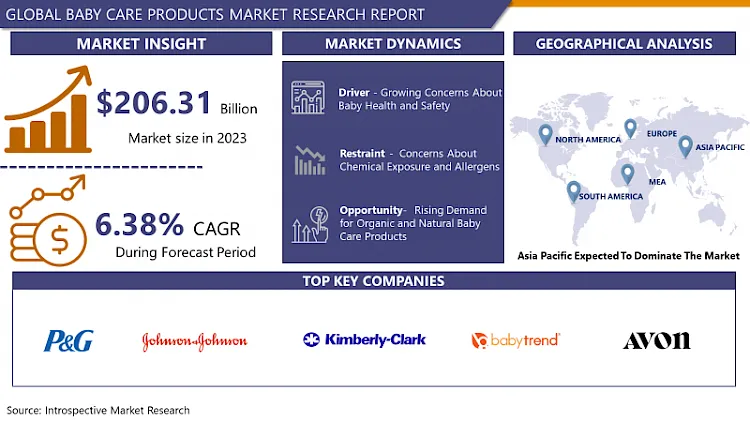Baby Care Products Market Synopsis
Baby Care Products Market Size Was Valued at USD 206.31 Billion in 2023, and is Projected to Reach USD 359.96 Billion by 2032, Growing at a CAGR of 6.38% From 2024-2032.
Baby care products typically refer to a range of items designed to meet the needs of infants and young children. These products can include diapers, baby wipes, baby shampoo, baby lotion, baby oil, baby powder, diaper rash cream, baby bottles, pacifiers, baby formula, baby food, baby clothes, baby blankets, baby toys, and other items essential for the care, hygiene, and comfort of babies and toddlers.
- Baby care products are essential for infants and toddlers, ensuring their health, hygiene, and comfort. Common items include diapers, wipes, bath products, lotion/oil, baby powder, clothing, bedding, feeding products, pacifiers, thermometers, nail care, car seats and strollers, toys and entertainment, safety products, and healthcare products. Diapers absorb urine and feces, while wipes clean during diaper changes and wipe messy hands. Bath products include shampoo, soap, and body wash, while lotion and oil moisturize and soothe delicate skin. Baby powder absorbs moisture and reduces friction, especially in areas prone to diaper rash. Bedding items include crib sheets, blankets, mattress protectors, and crib bumpers, providing a comfortable sleeping environment.
- Feeding products include bottles, bottle brushes, breast pumps, formula, and baby food. Pacifiers soothe babies and satisfy their natural sucking reflex, while thermometers help monitor fever and illness. Nail care includes clippers and files to trim and maintain nails. Car seats and strollers provide protection and comfort while traveling. Toys and entertainment stimulate babies' senses and encourage development. Safety products include baby gates, outlet covers, cabinet locks, and corner guards. Healthcare products include nasal aspirators, saline drops, teething gels, and pain relievers to manage common health issues. The global population growth, increasing in babies each year, drives the demand for baby care products.
- Parents are becoming more aware of the importance of products designed for babies' delicate skin and well-being, leading to a demand for safer, more natural options. As more parents work outside the home, there is a greater demand for convenient solutions like disposable diapers and pre-made formulas. Health and hygiene are top priorities, with products like wipes, lotions, shampoos, and soaps playing a crucial role. Fashion trends and changing preferences also influence the popularity of baby care items. Gift giving is another significant factor, with products often given as gifts for occasions like baby showers and birthdays. Despite economic fluctuations, spending on baby care products remains stable, with essential purchases like diapers and formula being essential.


Baby Care Products Market Trend Analysis
Growing Concerns About Baby Health and Safety
- The baby care products industry is experiencing a surge in concerns about baby health and safety due to various factors. Health-conscious parents are increasingly seeking safe, non-toxic products, with a preference for natural and organic ingredients over synthetic ones. Stringent product safety regulations are in place to ensure product safety and quality, building trust with consumers.
- Increased information accessibility has also influenced this trend, with parents having access to vast amounts of information online, enabling them to research and educate themselves about potential risks associated with certain ingredients. Media coverage of product recalls and safety scandals has heightened parental concerns, leading to increased scrutiny and demand for safer alternatives.
- Consumers are also demanding transparency from manufacturers regarding the ingredients used in baby care products and their potential health implications. Companies that provide clear information about product safety and sourcing are likely to gain a competitive edge. Health-conscious lifestyle trends are also driving this trend, with parents seeking products that align with their values and lifestyle choices, including those that prioritize environmental sustainability and ethical sourcing practices.
Restraint
Concerns About Chemical Exposure and Allergens
- Concerns about chemical exposure and allergens in baby care products are increasing due to research suggesting exposure to chemicals like parabens, phthalates, and fragrances may cause adverse health effects, including skin irritation and allergic reactions. Parents and caregivers are becoming more vigilant about ingredient lists and seeking safer alternatives. This trend has led to companies reformulating their products to eliminate or reduce the use of harmful substances.
- Manufacturers are developing products labeled as "hypoallergenic," "fragrance-free," "paraben-free," and "phthalate-free," while organic and natural brands are gaining popularity. Regulatory bodies and advocacy groups are implementing stricter regulations on labeling and formulation, as well as conducting research into the potential health impacts of common chemicals in these products.
Opportunity
Rising Demand for Organic and Natural Baby Care Products
- The growing demand for organic and natural baby care products presents a significant opportunity in the market. Parents are becoming more aware of the harmful effects of chemicals and synthetic ingredients in traditional products, leading to a shift towards organic alternatives. Health and safety concerns are also driving parents to seek safer alternatives, such as plant-based ingredients, which are perceived as gentler on sensitive baby skin.
- However, there is a growing preference for environmentally sustainable and eco-friendly options, with organic and natural baby care products often using ingredients sourced from sustainable and renewable resources and produced using eco-friendly manufacturing practices. The market for organic and natural baby care products is experiencing rapid growth, providing opportunities for both established companies and new entrants to expand their product offerings and capture a larger share of the market.
- Organic and natural baby care products often command higher price points, allowing companies to achieve higher profit margins by catering to consumers willing to pay a premium for safer and higher quality products. Innovation and product differentiation are also opportunities for companies in the baby care products industry to stand out in a crowded market and attract discerning consumers.
Challenge
Consumers are Increasingly Demanding Transparency Regarding the Ingredients
- Consumers are demanding transparency regarding the ingredients of baby care products due to safety concerns, health awareness, allergies, sensitivities, ethical and environmental concerns, and regulatory scrutiny. Safety concerns arise from parents and caregivers wanting assurance that the ingredients are safe and won't harm their child's health. Health awareness is growing, leading to a preference for natural or organic ingredients.
- Allergies and sensitivities can cause skin irritation or adverse reactions, so parents want to know exactly what is in their products. Ethical and environmental concerns arise from the environmental impact of the ingredients and the ethical practices of the companies producing them. Regulatory scrutiny is also increasing, with manufacturers facing pressure to provide detailed ingredient lists and demonstrate product safety. Overall, consumers are demanding transparency and understanding of the ingredients of baby care products.
Baby Care Products Market Segment Analysis:
Baby Care Products Market Segmented based on product type, age, and distribution channel.
By Product Type, the Baby Skincare Products segment is expected to dominate the market during the forecast period
- The demand for specialized skincare products for babies is on the rise due to parents' growing awareness of the importance of their skin's health. Babies are prone to skin conditions like diaper rash, eczema, and dry skin, leading to a higher demand for specialized products. Parents are also becoming more discerning about the ingredients used in baby products, preferring natural and gentle ones.
- Hypoallergenic and organic options are particularly popular among parents. The Baby Skincare Products segment offers a diverse range of products, allowing parents to customize their routines. With rising disposable income levels, parents are willing to invest in premium skincare products. Social media and marketing influence consumer preferences and drive demand for certain brands and formulations.
By Age, the Infants segment held the largest share of 29.6% in 2023
- Infants have essential needs that require a wide range of products, including diapers, baby wipes, skincare products, and baby food. These products are necessary for their daily care and hygiene, leading to consistent demand within this age group. Infants typically require more frequent diaper changes, feeding, and skincare compared to older children. As a result, parents of infants tend to purchase baby care products more frequently, contributing to a larger share of the market.
- New parents, particularly first-time parents, often invest heavily in baby care products for their newborns. They are more likely to purchase a variety of products to ensure the health and well-being of their infants, leading to increased sales within the Infants segment. Infancy is a critical growth phase, and parents are particularly sensitive to the quality and safety of products used during this period. They are more likely to invest in premium and trusted brands, driving higher revenue within the Infants segment.
Baby Care Products Market Regional Insights:
Asia Pacific is Expected to Dominate the Market Over the Forecast Period
- The Asia-Pacific region, with a growing population, is experiencing a surge in demand for baby care products like diapers, wipes, lotions, and food. Economic development in the region has led to higher disposable income, allowing parents to invest more in high-quality products. Urbanization is also driving market growth, with urban consumers having higher purchasing power. The rise of dual-income households and changing lifestyles has led to a demand for convenient, time-saving solutions like disposable diapers and pre-moistened wipes.
- As education levels and access to information increase, parents are becoming more aware of the importance of safe, high-quality products. The expansion of retail distribution channels, including online platforms and specialty baby stores, has made products more accessible to consumers in both urban and rural areas, contributing to the market growth.
Baby Care Products Market Top Key Players:
- Procter & Gamble (US)
- Johnson & Johnson (US)
- Kimberly-Clark Corporation (US)
- Baby Trend, Inc. (US)
- Avon Products, Inc. (US)
- Abbott Laboratories (US)
- The Clorox Company (US)
- Mead Johnson Nutrition Company (US)
- Naterra International, Inc. (US)
- Henkel AG & Co. KGaA (Germany)
- Beiersdorf AG (Germany)
- Reckitt Benckiser Group plc (United Kingdom)
- Unilever (United Kingdom/Netherlands)
- Danone S.A. (France)
- Weleda AG (Switzerland)
- Nestlé S.A. (Switzerland)
- Dabur India Limited (India)
- The Himalaya Drug Company (India)
- Kao Corporation (Japan)
- Pigeon Corporation (Japan)
- Kimberly-Clark Australia Pty Limited (Australia), and other major players
Key Industry Developments in the Baby Care Products Market:
- In June 2024, Lifelong Online, a prominent Indian e-commerce brand for consumer goods, entered the thriving baby care market by introducing a new category of baby products. The company aimed to revolutionize modern parenting by offering innovative and safe products. This new line included wearable breast pumps, strollers, bottle warmers, collapsible baby bathtubs, anti-slip baby bathers, and baby car seats. These advanced products were designed to enhance convenience and provide peace of mind for busy parents, ensuring the safety and well-being of their children.
- In January 2024, Pampers launched an all-new and enhanced range of Premium Care Diapers for babies. Featuring a unique 360-degree cottony softness, the improved Pampers Premium Care Diaper made babies feel like they were wearing nothing at all while receiving all the benefits of an all-in-one diaper. It boasted an inbuilt anti-rash blanket and lotion with aloe vera, safeguarding the delicate skin of the baby from rashes. The launch marked a significant advancement in baby care, ensuring comfort and protection for little ones.
|
Global Baby Care Products Market |
|||
|
Base Year: |
2023 |
Forecast Period: |
2024-2032 |
|
Historical Data: |
2017 to 2023 |
Market Size in 2023: |
206.31 Bn |
|
Forecast Period 2024-32 CAGR: |
6.38 % |
Market Size in 2032: |
359.96 Bn |
|
Segments Covered: |
By Product Type |
|
|
|
By Age |
|
||
|
By Distribution Channel |
|
||
|
By Region |
|
||
|
Key Market Drivers: |
|
||
|
Key Market Restraints: |
|
||
|
Key Opportunities: |
|
||
|
Companies Covered in the report: |
|
||
INTRODUCTION
RESEARCH OBJECTIVES
RESEARCH METHODOLOGY
RESEARCH PROCESS
SCOPE AND COVERAGE
Market Definition
Key Questions Answered
MARKET SEGMENTATION
EXECUTIVE SUMMARY
MARKET OVERVIEW
GROWTH OPPORTUNITIES BY SEGMENT
MARKET LANDSCAPE
PORTER’S FIVE FORCES ANALYSIS
Bargaining Power Of Supplier
Threat Of New Entrants
Threat Of Substitutes
Competitive Rivalry
Bargaining Power Among Buyers
INDUSTRY VALUE CHAIN ANALYSIS
MARKET DYNAMICS
Drivers
Restraints
Opportunities
Challenges
MARKET TREND ANALYSIS
REGULATORY LANDSCAPE
PESTLE ANALYSIS
PRICE TREND ANALYSIS
PATENT ANALYSIS
TECHNOLOGY EVALUATION
MARKET IMPACT OF THE RUSSIA-UKRAINE WAR
Geopolitical Market Disruptions
Supply Chain Disruptions
Instability in Emerging Markets
ECOSYSTEM
BABY CARE PRODUCTS MARKET BY PRODUCT TYPE (2017-2032)
BABY CARE PRODUCTS MARKET SNAPSHOT AND GROWTH ENGINE
MARKET OVERVIEW
DIAPERS
Introduction And Market Overview
Historic And Forecasted Market Size in Value (2017 – 2032F)
Historic And Forecasted Market Size in Volume (2017 – 2032F)
Key Market Trends, Growth Factors And Opportunities
Geographic Segmentation Analysis
BABY WIPES
BABY FOOD
BABY SKINCARE PRODUCTS
BABY CLOTHING
TOYS
BABY CARE PRODUCTS MARKET BY AGE (2017-2032)
BABY CARE PRODUCTS MARKET SNAPSHOT AND GROWTH ENGINE
MARKET OVERVIEW
NEWBORNS
Introduction And Market Overview
Historic And Forecasted Market Size in Value (2017 – 2032F)
Historic And Forecasted Market Size in Volume (2017 – 2032F)
Key Market Trends, Growth Factors And Opportunities
Geographic Segmentation Analysis
INFANTS
TODDLERS
PRESCHOOLERS
BABY CARE PRODUCTS MARKET BY DISTRIBUTION CHANNEL (2017-2032)
BABY CARE PRODUCTS MARKET SNAPSHOT AND GROWTH ENGINE
MARKET OVERVIEW
SUPERMARKETS/HYPERMARKETS
Introduction And Market Overview
Historic And Forecasted Market Size in Value (2017 – 2032F)
Historic And Forecasted Market Size in Volume (2017 – 2032F)
Key Market Trends, Growth Factors And Opportunities
Geographic Segmentation Analysis
SPECIALTY STORES
ONLINE RETAIL
PHARMACIES
CONVENIENCE STORES
COMPANY PROFILES AND COMPETITIVE ANALYSIS
COMPETITIVE LANDSCAPE
Competitive Positioning
Baby Care Products Market Share By Manufacturer (2023)
Industry BCG Matrix
Heat Map Analysis
Mergers & Acquisitions
PROCTER & GAMBLE (US)
Company Overview
Key Executives
Company Snapshot
Role of the Company in the Market
Sustainability and Social Responsibility
Operating Business Segments
Product Portfolio
Business Performance (Production Volume, Sales Volume, Sales Margin, Production Capacity, Capacity Utilization Rate)
Key Strategic Moves And Recent Developments
SWOT Analysis
JOHNSON & JOHNSON (US)
KIMBERLY-CLARK CORPORATION (US)
BABY TREND, INC. (US)
AVON PRODUCTS, INC. (US)
ABBOTT LABORATORIES (US)
THE CLOROX COMPANY (US)
MEAD JOHNSON NUTRITION COMPANY (US)
NATERRA INTERNATIONAL, INC. (US)
HENKEL AG & CO. KGAA (GERMANY)
BEIERSDORF AG (GERMANY)
RECKITT BENCKISER GROUP PLC (UNITED KINGDOM)
UNILEVER (UNITED KINGDOM/NETHERLANDS)
DANONE S.A. (FRANCE)
WELEDA AG (SWITZERLAND)
NESTLÉ S.A. (SWITZERLAND)
DABUR INDIA LIMITED (INDIA)
THE HIMALAYA DRUG COMPANY (INDIA)
KAO CORPORATION (JAPAN)
PIGEON CORPORATION (JAPAN)
KIMBERLY-CLARK AUSTRALIA PTY LIMITED (AUSTRALIA)
GLOBAL BABY CARE PRODUCTS MARKET BY REGION
OVERVIEW
NORTH AMERICA
Key Market Trends, Growth Factors And Opportunities
Key Manufacturers
Historic And Forecasted Market Size By Product Type
Historic And Forecasted Market Size By Age
Historic And Forecasted Market Size By Distribution Channel
Historic And Forecasted Market Size By Country
USA
Canada
Mexico
EASTERN EUROPE
Key Market Trends, Growth Factors And Opportunities
Key Manufacturers
Historic And Forecasted Market Size By Segments
Historic And Forecasted Market Size By Country
Russia
Bulgaria
The Czech Republic
Hungary
Poland
Romania
Rest Of Eastern Europe
WESTERN EUROPE
Key Market Trends, Growth Factors And Opportunities
Key Manufacturers
Historic And Forecasted Market Size By Segments
Historic And Forecasted Market Size By Country
Germany
United Kingdom
France
The Netherlands
Italy
Spain
Rest Of Western Europe
ASIA PACIFIC
Key Market Trends, Growth Factors And Opportunities
Key Manufacturers
Historic And Forecasted Market Size By Segments
Historic And Forecasted Market Size By Country
China
India
Japan
South Korea
Malaysia
Thailand
Vietnam
The Philippines
Australia
New-Zealand
Rest Of APAC
MIDDLE EAST & AFRICA
Key Market Trends, Growth Factors And Opportunities
Key Manufacturers
Historic And Forecasted Market Size By Segments
Historic And Forecasted Market Size By Country
Turkey
Bahrain
Kuwait
Saudi Arabia
Qatar
UAE
Israel
South Africa
SOUTH AMERICA
Key Market Trends, Growth Factors And Opportunities
Key Manufacturers
Historic And Forecasted Market Size By Segments
Historic And Forecasted Market Size By Country
Brazil
Argentina
Rest of South America
INVESTMENT ANALYSIS
ANALYST VIEWPOINT AND CONCLUSION
Recommendations and Concluding Analysis
Potential Market Strategies
|
Global Baby Care Products Market |
|||
|
Base Year: |
2023 |
Forecast Period: |
2024-2032 |
|
Historical Data: |
2017 to 2023 |
Market Size in 2023: |
206.31 Bn |
|
Forecast Period 2024-32 CAGR: |
6.38 % |
Market Size in 2032: |
359.96 Bn |
|
Segments Covered: |
By Product Type |
|
|
|
By Age |
|
||
|
By Distribution Channel |
|
||
|
By Region |
|
||
|
Key Market Drivers: |
|
||
|
Key Market Restraints: |
|
||
|
Key Opportunities: |
|
||
|
Companies Covered in the report: |
|
||








